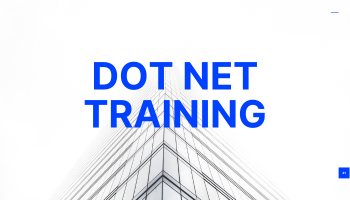Your cart is currently empty.
Dot Net is a free, open-source, cross-platform framework developed by Microsoft for building various types of applications. It provides a comprehensive and consistent programming model and supports multiple programming languages, including C#, F#, and Visual Basic. The .NET framework is widely used for developing applications ranging from desktop to web and mobile. The introduction of .NET Core and the subsequent unification into .NET 5 and later versions marked a significant shift toward a more modular and cross-platform framework. It has enhanced performance, scalability, and flexibility, making it a versatile choice for modern application development across different domains. Cranesoft provides the best DotNet training in Bangalore

Online-Classroom
3 Months Duration
Live Class Facilities
Interviews Assured
Live Server
Microsoft .NET, commonly referred to as simply ".NET," is a software framework developed by Microsoft. It provides a platform for building, deploying, and running various types of applications, including web applications, desktop applications, mobile applications, cloud-based applications, and more. The .NET framework supports multiple programming languages and is designed to facilitate interoperability and seamless communication between different components and technologies. Cranesoft provides the best DotNet training in Bangalore with placements.
Common Language Runtime (CLR)
The CLR is the execution environment for .NET applications. It provides services such as automatic memory management, security, and exception handling. The CLR allows different programming languages to be used within the same application, promoting language interoperability.
Base Class Library (BCL)
The BCL is a comprehensive library of classes and functions that provide a wide range of functionalities for developers. It includes classes for data access, file I/O, networking, security, and more.
ASP.NET
A framework for building dynamic web applications and services. ASP.NET supports various technologies such as Web Forms for rapid development, MVC (Model-View-Controller) for building scalable web applications, and Web API for creating web services.
WinForms and WPF
These are frameworks for building Windows desktop applications. Windows Forms (WinForms) provides a traditional approach to creating desktop applications, while Windows Presentation Foundation (WPF) offers a more modern and flexible user interface design.
Entity Framework
An Object-Relational Mapping (ORM) framework that simplifies database interactions by allowing developers to work with databases using .NET objects.
Xamarin
A cross-platform mobile app development framework that allows developers to use .NET and C# to build native applications for iOS, Android, and Windows.
.NET Core and .NET 5/6+
NET Core is the open-source, cross-platform version of the .NET framework. Starting with .NET 5, Microsoft unified .NET Core and .NET Framework into a single, cross-platform framework known as .NET, providing a consistent development experience across different operating systems.
Language Integration
.NET supports multiple programming languages, including C#, F#, Visual Basic, and others. Developers can choose the language that best suits their preferences and requirements.
A well-structured curriculum covering essential topics in .NET development, including C# programming, ASP.NET for web development, WinForms or WPF for desktop applications, and relevant technologies like Entity Framework.
Practical, hands-on exercises and projects that allow participants to apply theoretical knowledge in real-world scenarios. Practical experience is crucial for skill development.
Training conducted by experienced instructors who are knowledgeable about .NET development and can provide valuable insights based on industry experience.
Focus on skills that are in demand in the industry, including the latest trends and best practices in .NET development.
Interactive sessions that encourage participant engagement, questions, and discussions. This enhances the learning experience and allows participants to clarify doubts.
Preparation for relevant certifications, if applicable. Certification can add value to a participant's credentials and demonstrate proficiency in .NET development.
Training on practical tools, development environments, and techniques commonly used in .NET development.
A collaborative learning environment that encourages networking and interaction among participants. Learning from peers can be valuable.
Access to resources such as course materials, documentation, and additional learning materials to support ongoing learning.
Some training programs may offer job placement assistance or guidance on entering the workforce after completing the training.
Via .NET Developer, As a .NET developer, you can work on designing, developing, testing, and maintaining applications using the .NET framework. This includes web applications, desktop applications, and mobile applications.
Via Web Developer (ASP.NET),Specializing in web development using ASP.NET, you can focus on creating dynamic and interactive web applications. This may involve working with ASP.NET Web Forms, ASP.NET MVC, or ASP.NET Core.
Via Desktop Application Developer (WinForms/WPF),Developing Windows desktop applications using Windows Forms (WinForms) or Windows Presentation Foundation (WPF) is another specialization. This is common for roles focused on creating standalone applications for Windows.
Via Mobile App Developer (Xamarin),With expertise in Xamarin, you can pursue a career in mobile app development. Xamarin allows you to build cross-platform mobile applications using C# and the .NET framework.
Via Full-Stack Developer,As a full-stack developer, you can work on both the front-end (user interface) and back-end (server-side) development. This may involve proficiency in technologies such as HTML, CSS, JavaScript, and databases in addition to .NET.
Via Database Developer,Specializing in database development, you can work on designing and optimizing database structures, writing queries, and ensuring efficient data storage and retrieval in .NET applications.
Via DevOps Engineer,DevOps roles involve working on the continuous integration and deployment (CI/CD) processes, ensuring the smooth release and operation of applications. Knowledge of .NET can be valuable in such roles.
Via Cloud Developer,As cloud computing becomes more prevalent, developers with expertise in deploying and managing .NET applications on cloud platforms, such as Microsoft Azure, can find opportunities in cloud development roles.
Via Systems Architect,With experience in .NET architecture, you can progress to roles where you design the overall structure of complex systems, ensuring scalability, reliability, and performance.
Via Technical Lead or Project Manager,As you gain experience, you may move into leadership roles, overseeing development teams, managing projects, and making strategic decisions related to software development.
Via Consultant or Trainer,Some professionals choose to become consultants or trainers, offering expertise to organizations or individuals seeking guidance on .NET development best practices or providing training sessions.